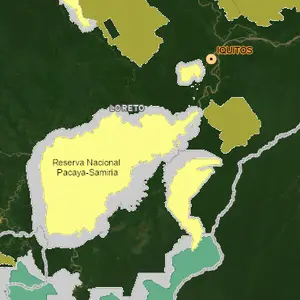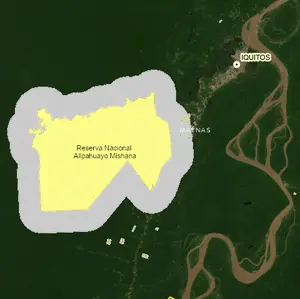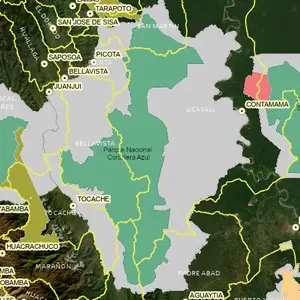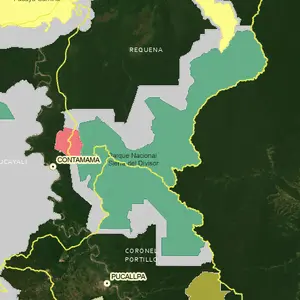Peru Travel Guide
Comprehensive Travel Guide for Herpers, Birders, and Ecotourists
Exploring Peru: A Comprehensive Guide for Wildlife Enthusiasts, Herpers, and Ecotourists
Introduction to Peru
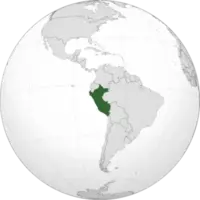
Attribution: Addicted04, CC BY-SA 3.0
Peru is a country of remarkable diversity, offering landscapes that range from the towering peaks of the Andes to the lush, expansive rainforests of the Amazon Basin. While the entire nation is a treasure trove for wildlife enthusiasts, herpers, birders, and ecotourists, the Peruvian Amazon stands out as an unparalleled destination for those seeking deep immersion in one of the most biodiverse regions on Earth. Home to thousands of unique species of plants, animals, and insects, this vast, verdant ecosystem covers over 60% of Peru, sheltering creatures as elusive as jaguars and as colorful as macaws. Exploring Peru means not only discovering its rich cultural heritage and varied geography but also experiencing the delicate interconnections within its natural world, with the Amazon at the heart of it all.
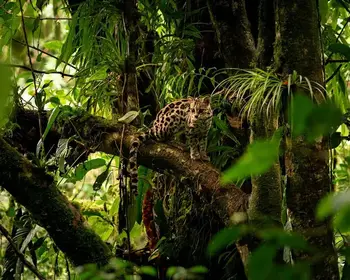
This travel guide provides a comprehensive look at Peru, designed with a special focus on the Amazon region, where conservation and eco-friendly tourism have created unique opportunities for wildlife viewing and hands-on learning. From the cloud forests along the eastern slopes of the Andes to the deep, remote jungles accessed by riverboat, the Peruvian Amazon offers something extraordinary for everyone passionate about nature. Key wildlife areas such as Manu National Park, the Tambopata National Reserve, and the Pacaya Samiria National Reserve are among the best places to observe rare reptiles, amphibians, and birds, along with countless plant species, many of which are found nowhere else on the planet. Yet, Peru’s Amazon region also provides a chance to engage with the Indigenous communities who live there, learning about sustainable living practices and conservation efforts from those who have called this land home for centuries.
Whether you are planning your first trip to Peru or returning to deepen your exploration, this guide will equip you with essential information about Peru’s diverse regions, focusing especially on how to make the most of your journey through the Amazon. From understanding local languages and customs to finding the best wildlife viewing spots and preparing for the unique conditions of the rainforest, this guide will serve as a practical resource. Peru is a land that rewards curiosity and respect, offering the chance to connect with its rich natural and cultural heritage, making each visit a truly unforgettable adventure.
Understanding Peru: Geography, Climate, and Biodiversity
Exploring Peru’s Diverse Geographic Regions

Peru’s geographic diversity is a key reason it ranks among the world’s most ecologically rich countries, with each region offering unique habitats and wildlife. The country is typically divided into three main regions: the coastal desert, the Andes, and the Amazon Basin. The coastal desert region, while arid, is interspersed with rich river valleys that create small green oases. Coastal areas also house Peru’s unique marine reserves, where enthusiasts can witness vibrant seabird colonies, sea lions, and occasional whales. Although the coast may be less known for reptiles and amphibians, it is rich in bird life, with endemic species such as the Peruvian Pelican and the Humboldt Penguin, which thrive along its nutrient-rich shores.

The Andes, the spine of Peru, rise dramatically from the coastal plain and create a high-altitude realm of cloud forests, grasslands, and steep mountain valleys. This rugged landscape is home to a fascinating array of species that have adapted to its elevations, including Andean condors, spectacled bears, and unique highland reptiles like the Andean Lizard. The eastern slopes of the Andes are particularly significant for herpers and birders, as these cloud forests act as a transitional zone into the Amazon Basin, harboring rare amphibians and colorful bird species such as the Andean Cock-of-the-Rock. The Andes are also home to many Indigenous communities who continue to maintain a close connection with the land and are often involved in conservation and ecotourism initiatives.
Peru’s Amazon Basin, covering over half the country, is a prime destination for wildlife enthusiasts, with dense rainforests and iconic rivers like the Amazon and the Rio Madre de Dios teeming with life. These waterways create essential habitats for an astonishing range of species, including caimans, river turtles, pink river dolphins, and a variety of birds like macaws and toucans. For herpers, the rainforest’s vibrant mix of reptiles and amphibians—from poison dart frogs to arboreal snakes—provides countless opportunities for sightings, while birders enjoy unparalleled access to tropical bird species along the river’s forested banks. Exploring by boat offers a deep immersion into these rich ecosystems, where the floodplains, oxbow lakes, and marshes reveal Peru’s Amazon Basin as a true haven for biodiversity and an unforgettable experience for ecotourists.
Political Regions of Peru
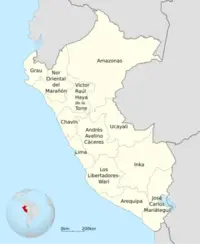
Peru is divided into 24 departments, or political regions, plus the Constitutional Province of Callao, each with distinct cultural and ecological characteristics. The departments are generally organized into three main areas: coastal, highland (Andean), and Amazonian regions, each reflecting the diverse geography that shapes life within its boundaries. The coastal departments, including Lima, Ica, and Piura, are known for their urban centers, historic sites, and arid desert landscapes. In contrast, highland regions like Cusco, Arequipa, and Puno are steeped in Andean culture, home to historic Inca ruins, traditional villages, and landscapes that span altitudes from valleys to mountain peaks. Meanwhile, the Amazonian departments—including Loreto, Ucayali, and Madre de Dios—offer access to vast rainforests, abundant rivers, and rich biodiversity, drawing ecotourists eager to explore the Amazon Basin’s unique flora and fauna. Each region has its own local governance and economic focus, with the Amazonian departments particularly known for conservation efforts and ecotourism, as well as Indigenous communities whose deep-rooted knowledge and practices are essential to preserving these vital ecosystems.
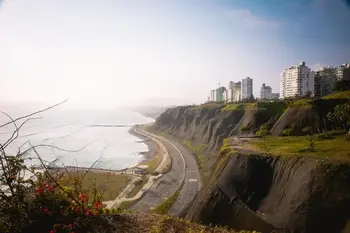
Lima Province, the heart of Peru, is home to the bustling capital city of Lima, a vibrant metropolis that serves as the nation’s political, cultural, and economic hub. Here, travelers will find a unique blend of modernity and history, with ancient archaeological sites like Huaca Pucllana and world-class museums such as the Larco Museum showcasing Peru’s rich past. Lima is also a culinary capital, renowned for its fusion of flavors from across the country, making it a destination for food enthusiasts. While urban and largely coastal, Lima is often the entry point for travelers heading to Peru’s more remote ecotourism destinations in the Amazon or Andes.
Loreto Department, located in the northern Amazon Basin, is the gateway to Peru’s dense rainforests and is home to Iquitos, the most isolated large city in the country. Known as the “Capital of the Amazon,” Iquitos is accessible only by air or by boat along the Amazon River, underscoring its unique position deep within the jungle. Loreto offers unparalleled opportunities for ecotourism, with numerous ecolodges and river tours that allow visitors to explore the Amazon’s vast biodiversity. From Iquitos, travelers can venture into remote wildlife reserves and Indigenous territories, where they can experience Peru’s rainforest ecosystems and encounter species found nowhere else in the world.
Madre de Dios, situated in southeastern Peru, is another major ecotourism destination, known especially for the Tambopata National Reserve, a renowned biological hotspot. Often called the “Biodiversity Capital of Peru,” Madre de Dios is one of the richest ecosystems on Earth, attracting ecotourists, herpers, and birders who are eager to witness its dense jungle and abundant wildlife. Puerto Maldonado, the region’s capital, is the main point of access, offering boat tours and lodge stays along the Madre de Dios River. This department is a priority for conservation efforts, with many protected areas where visitors can experience the Amazon’s lush forests and diverse animal life.

Cusco Department (also spelled Cuzco), located in the southern highlands, is world-famous as the home of the ancient Incan capital city of Cusco, and the iconic archaeological site of Machu Picchu. High in the mountains, Cusco is a cultural and historical treasure, where Indigenous Quechua heritage and Incan architecture remain integral to everyday life. Besides its archaeological wonders, Cusco also serves as a gateway to the Sacred Valley, where visitors can hike through breathtaking landscapes and spot Andean species. From Cusco, travelers can experience a unique mix of Andean culture, history, and nature, making it a must-visit region for anyone exploring Peru.
Peru Weather Patterns:
Best Times for Birding, Herping, and Exploring
Peru’s climate varies widely due to its geography, with each region experiencing distinct weather patterns. The coastal deserts, spanning the length of Peru’s western coastline, are characterized by arid conditions and mild temperatures year-round. This region receives very little rainfall, with some areas seeing less than 10 millimeters annually, particularly in the far south. Coastal temperatures generally range from 15°C (59°F) in winter (June to September) to 26°C (79°F) in summer (December to March). While the coastal deserts don’t have a true rainy season, fog and mist from the Pacific Ocean create a phenomenon called “garúa” in winter, bringing cooler, humid conditions, especially around Lima and further south.
The Andes, stretching through central Peru, experience highly variable weather, depending on altitude. Generally, the Andes have two main seasons: the dry season from May to September and the rainy season from October to April. During the dry season, temperatures in high-altitude areas like Cusco and Puno can range from 0°C (32°F) at night to 18°C (64°F) during the day, with clear skies and ideal trekking conditions. The rainy season brings heavy rainfall, particularly from January to March, with some areas receiving over 700 millimeters of rain. Temperatures remain moderate during this period, typically ranging from 6°C (43°F) to 22°C (72°F), though trails may be muddy and more challenging to navigate.
In the Amazon Basin, the climate is tropical, with high temperatures and humidity throughout the year. Daytime temperatures in the Amazon typically range from 25°C (77°F) to 33°C (91°F), with night temperatures rarely dropping below 20°C (68°F). The Amazon has a rainy season from December to May, during which the region can receive up to 3,000 millimeters of rainfall, causing river levels to rise and flood parts of the rainforest. June to November is considered the dry season, with less frequent rainfall but still high humidity. Wildlife sightings can be particularly rewarding during this time, as animals gather around remaining water sources, and trails are more accessible. However, the best time to visit the Peruvian Amazon Basin for herping is, arguably, during the wet season.
The Humboldt Current, a cold ocean current flowing from the southern Pacific, significantly impacts Peru’s coastal climate by keeping temperatures mild and reducing rainfall along the coast. During El Niño events, however, this current weakens, leading to warmer sea temperatures, increased rainfall, and flooding along Peru’s northern coast. In the Tropical Andes, El Niño can cause heavy rainfall on the lower seaward (west) slopes, but the higher elevations and eastern slopes are usually warm and dry. In northern Peru, El Niño can cause heavy rainfall and flooding along the coast during the austral summer (December–January–February). Conversely, La Niña strengthens the Humboldt Current, leading to cooler sea temperatures, drier coastal conditions, and in some cases, more severe droughts. In the Andes, La Niña events result in reduced rainfall, often causing drought conditions, especially in the central and southern Andean areas; essentially, El Niño brings more rain to the coastal areas while La Niña brings drier conditions to the Andes. The Amazon Basin, on the other hand, especially in the North tends to receive more rainfall during La Niña years, while bringing drier conditions to the tropical savannas south of the Amazon rainforest.
What is the Best Time to Visit the Amazon for Herping, Birding, and Wildlife Viewing?
Herping. The wet season, December through May in the Amazon basin, as a rule of thumb is usually the best time of year for herping.
Birding. The nesting season, is often a great time for observing and predicting the movements of birds. Unlike in temperate regions of the world, nesting season in the tropics is not necessarily during the spring time. Nesting season is species and location specific, but often coincides with the fruiting of their favorite food source. Be sure to do your own research on the best time to view a particular species in a particular region. Reach out to the lodge staff, where you intend to stay to get their advice on the best time of year to view a particular species.
General wildlife viewing. The wet and the dry seasons each have their advantages and disadvantages for wildlife viewing. The wet season (and high water season in the Amazon basin) is the time when many trees drop their fruit, which attracts, birds, monkeys, and other wildlife. The wet season is the most favorable time for amphibians to be on the move and for breeding, and amphibians and their eggs and tadpoles provide food for many predators. The disadvantage of the high water season is accessibility. Trails and roads are often flooded, limiting access to particular areas. During the dry season, on the other hand, food resources are often more scarce, which reduces observations in general, especially from migratory animals or animals that can estivate. However, certain species may become concentrated at the remaining water sources, making them easier to locate, and hiking is also much easier during this time.

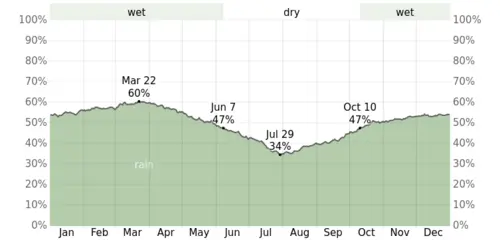

Peru’s Rich Biodiversity:
A Guide for Birders, Herpers, and Wildlife Enthusiasts

Peru is one of the world’s most biodiverse countries, ranking in the top 10 for biodiversity globally, with a particularly high concentration of species in its Amazon Basin. The country is home to over 25,000 species of plants, 5,000 species of fish, and an estimated 1,800 species of birds, of which 120 are endemic to Peru. Additionally, Peru hosts around 500 species of mammals and over 400 species of amphibians, and 469 known species of reptiles, with new species regularly discovered in its dense rainforests. The Amazon Basin, covering over 60% of Peru, is a biodiversity hotspot that supports some of the most complex ecosystems on Earth. Within this region, Manu National Park alone boasts more than 1,000 bird species—equivalent to 10% of all known bird species globally—and over 1,300 butterfly species. The Peruvian Amazon is also home to iconic species such as jaguars, pink river dolphins, giant otters, and black caimans, as well as countless reptiles and amphibians, making it an ideal destination for herpers and wildlife enthusiasts. This immense biodiversity is attributed to the Amazon’s vast, interconnected habitats, including floodplains, oxbow lakes, and cloud forests, all of which provide essential niches for thousands of species. Peru’s commitment to preserving these ecosystems through protected areas and sustainable tourism helps maintain its status as a global biodiversity sanctuary.
Discovering Peru’s Ecosystems:
Rainforests, Cloud Forests, Deserts, and More
Peru’s diverse geography gives rise to a remarkable variety of ecosystems, each home to unique assemblages of wildlife. Along the Pacific coast, the Humboldt current is a cold, low-salinity current that brings nutrients from the deep ocean to the surface, which drives biological productivity. Moving inland, the coastal deserts stretch through much of western Peru, characterized by sparse vegetation and occasional oases where desert-adapted species such as the desert lancehead viper (Bothrops pictus) thrive. The Andean highlands, which form the backbone of Peru, present a challenging, high-altitude environment where species like the Andean condor and the mountain caracara soar above, while highland frogs and Andean lizards, adapted to cooler temperatures, find refuge in rocky crevices and grasslands. Just below the high Andes, the cloud forests form an ecological transition zone between high mountains and the lowland rainforest. These cloud forests are shrouded in mist and rich in biodiversity, supporting amphibians like the glass frogs and reptiles such as the cloud forest anole. Among bird species, the cloud forests are famous for the Andean cock-of-the-rock and various hummingbirds, which thrive in this lush environment.
Further east, the landscape descends into the vast Amazon Basin, an ecosystem of staggering biodiversity. This tropical rainforest is home to hundreds of reptile species, such as the green anaconda and the black caiman, and an array of amphibians, including the colorful poison dart frogs. Birds are abundant here, too, with iconic species like the harpy eagle, scarlet macaw, and hoatzin commonly seen. The rainforest’s diverse ecosystems—ranging from river floodplains to upland terra firme forests—create habitats for countless other animals, plants, and insects, many of which are found nowhere else on Earth. These ecosystems not only support rich wildlife populations but also play a crucial role in maintaining global biodiversity, making Peru one of the most ecologically valuable countries worldwide.
Peru’s Iconic Wildlife:
Essential Sightings for Herpers, Birders, and Ecotourists
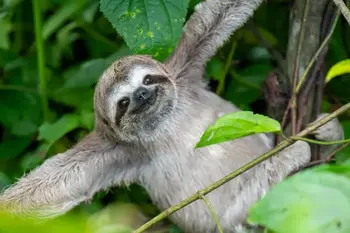
Peru is a paradise for herpers, with an impressive lineup of iconic reptile and amphibian species that make the Amazon Basin particularly exciting. Among these are the brilliantly colored poison dart frogs, and hundreds of other species of frogs. The region is also home to a variety of formidable snakes, including the massive green anaconda, one of the world’s heaviest snakes, and the elusive bushmaster, the world’s largest pit viper. Other favorites among herpers include the emerald tree boa and the beautiful rainbow boa, both known for their vibrant coloration and arboreal habits. Highly venomous and strikingly beautiful snakes like the aquatic coral snake and the infamous fer-de-lance further add to the intrigue of the Amazon, making Peru’s rainforests a premier destination for those fascinated by reptiles and amphibians.
Birders will find Peru’s rainforests equally captivating, with iconic bird species drawing enthusiasts from around the globe. Harpy eagles, powerful raptors with striking features, are one of the Amazon’s top avian predators and a thrilling sight for any visitor lucky enough to spot one. The forests are also filled with colorful toucans, their large beaks making them unmistakable, and parrots, including the spectacularly colored macaws that gather at clay licks to ingest minerals essential for their diet. These clay licks provide one of the Amazon’s most memorable spectacles, with flocks of macaws, parrots, and parakeets descending en masse to feed. Other notable species include the giant river otter, river turtles, and the playful pink river dolphin, which often inhabit Peru’s winding Amazonian rivers and oxbow lakes. Additionally, the elusive jaguar, though rarely seen, is another sought-after species for wildlife enthusiasts, as Peru remains one of the best places in South America to encounter these magnificent creatures. This array of iconic species truly highlights the richness and allure of Peru’s ecosystems for both herpers and birders.
Local Culture and Language
Understanding Peruvian Culture and Traditions as an Ecotourist
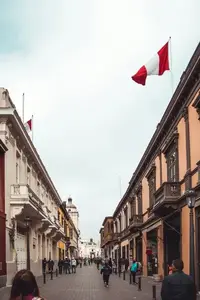
Peru’s cultural landscape is an intricate tapestry woven from Indigenous, Spanish, Afro-Peruvian, and Andean traditions, each adding unique layers to the nation’s identity. Indigenous cultures, including Quechua and Aymara in the Andes and diverse groups in the Amazon, form the deep-rooted heart of Peruvian society, contributing ancient customs, languages, and profound knowledge of the land. Their traditions and spirituality often center on harmony with nature and reverence for deities like Pachamama (Mother Earth), concepts that resonate strongly with ecotourism’s values of respect and conservation. Andean culture, in particular, reflects the resilience of Indigenous heritage despite Spanish colonial influence, preserving practices like agricultural rituals, textile weaving, and festivals such as Inti Raymi, an Inca celebration of the sun that persists alongside Catholic traditions.
Spanish colonialism, meanwhile, left an indelible mark on Peruvian society, bringing Catholicism, new architectural styles, and social customs that reshaped local communities. Catholicism remains widespread and deeply influential, with grand festivals such as Semana Santa (Holy Week) and Corpus Christi celebrated through vibrant processions, music, and dance, especially in cities like Cusco and Arequipa. Spanish influence in cuisine introduced European techniques and ingredients that have since blended with Indigenous flavors, producing iconic dishes like ají de gallina and ceviche, and forging a culinary identity that reflects Peru’s cultural fusion.
Afro-Peruvian culture, rooted in the history of enslaved Africans brought to Peru during the colonial period, adds another dimension to Peruvian identity, especially along the central and southern coasts. Afro-Peruvian music, dance, and food have greatly enriched the cultural landscape, with traditions like festejo and zapateo (distinctive Afro-Peruvian dances) gaining recognition in the wider national culture. Afro-Peruvian influences are also visible in dishes like tacu-tacu (a hearty rice and bean dish) and contribute to the country’s diversity in art and folklore. Together, these cultural influences make Peru a vibrant, multifaceted society where Indigenous, Andean, Spanish, and Afro-Peruvian traditions coexist and enrich each other. Ecotourists engaging with Peru’s cultural mosaic gain a deeper understanding of its historical layers and resilient cultural heritage. By interacting respectfully and curiously with these diverse customs, travelers can experience a connection to Peru that transcends its breathtaking landscapes, bridging the natural and cultural worlds that define this unique country.
Understanding and respecting local customs
While a comprehensive overview of Peruvian culture and customs is beyond the scope of this article, doing some additional research will be beneficial. That being said, respecting local customs is essential for ecotourists in Peru, where social norms vary between urban, rural, and Indigenous communities. In rural Andean communities, for instance, modest dress and respectful behavior are valued, and interactions are often formal, with greetings showing genuine warmth. When visiting Indigenous communities in the Amazon, it’s customary to seek permission before taking photographs and to be mindful of people’s privacy. Language can be a bridge to building rapport—simple greetings in Spanish or Quechua, like "Buenos días" (Good morning) or "Allillanchu" (Hello), are often welcomed warmly. In many parts of Peru, people hold nature and local deities in high regard, making it important for visitors to act with respect towards the environment, avoiding littering, and practicing leave-no-trace principles. By observing these customs, ecotourists not only show respect for local traditions but also help create meaningful connections and a positive experience for all involved.
The Spanish speaking inhabitants of Lima, as well as the tourist areas in the Amazon and Machu Picchu are immersed in Western culture and are accustomed to interacting with American and European tourists, making them understanding and tolerant of different cultures. However, taking the time to learn and respect their customs will be greatly appreciated by locals. As the saying goes, "When in Rome, do as the Romans do."
Do You Need to Know Spanish for Your Peru Ecotourism Adventure?
While it’s possible to enjoy Peru without fluency in Spanish, knowing some basics can greatly enhance your ecotourism experience. In popular ecotourism areas, such as Cusco, Iquitos, and Puerto Maldonado, guides and staff often speak English, but in remote areas or smaller communities, Spanish or local Indigenous languages like Quechua are more commonly spoken. Familiarity with key phrases in Spanish—such as asking for directions, ordering food, or greeting locals—can make communication smoother and demonstrate respect for the local culture. Learning words related to nature, like “pájaro” (bird), “serpiente” (snake), or “selva” (jungle), can also be particularly useful for wildlife enthusiasts. Make an effort to learn key phrases and nouns that will be useful during your trip, especially terms related to travel (like "taxi," "bus," and the names of towns) and the Spanish names for any species you’re hoping to spot. Additionally, Spanish can be invaluable in emergency situations, ensuring you can communicate your needs effectively. Ultimately, even minimal efforts to speak Spanish are generally appreciated and can open doors to richer interactions and insights during your time in Peru.
Downloading Google Translate to your phone for quick reference is strongly recommend—Peruvians are usually patient while you type in a translation, and many use the app themselves! Below, you'll find a table of key phrases and nouns that should come in handy in Peru.
Spanish Terms to Learn
| English | Spanish | Comment |
|---|---|---|
| I want | Yo quiero | You can drop the “Yo”, which means “I”, and simply say “quiero”, since the “I” is implied with this particular conjugation. |
| I need | Yo necesito | Or, simply just, "Necisito" |
| Yes | Sí | |
| No | No | |
| The | El/La/Los | Masculine/Feminine/Plural |
| Please | Por favor | |
| You're welcome | De nada | Con gusto, which translates to “with pleasure” is another popular way of saying "you're welcome". |
| To go to | ir a | Example: "Yo necesito ir a Lima" ↦ "I need to go to Lima". |
| Bus stop | Parada de autobús | Often, people will shorten it to “La parada” |
| Bus station | Estación de autobuses | |
| Taxi | Taxi | |
| Airport | Aeropuerto | |
| My suitcase | Mi maleta | |
| My passport | Mi pasaporte | |
| Ticket (bus) | Boleto | |
| Ticket office | Boletería | Look for the "Boletería" sign at bus stations. This is where you buy your bus ticket. |
| Bathroom | Baño | Bathroom, washroom, lavatory, latrine, water closet, or whatever you call the place with the toilet. |
| Where is the... | Dónde está el... | Example: "Where is the bathroom?" ↦ "Dónde esta el Baño". Note that está may not be the correct conjugation for what follows, and el may need to be replaced with la or los for proper grammar. However, most spanish speakers will still understand you even if your grammer ain't no good. |
| How much money | Cuánto dinero | |
| Left (direction) | Izquierda | A la izquierda means "on the left" or "to the left" |
| Right (direction) | Derecha | "La Derecha" means "on the right" or "to the right" |
| Close | Cerca | Example: "El hotel esta cerca" ↦ "The hotel is close" |
| Here | Aquí | Example: "Esta aquí" ↦ "It is here" |
| Sir | Señor | |
| Madam/Madame/Ma'am | Señora | |
| Excuse me (to get attention) |
Disculpe | Disculpe is used to get someone's attention, e.g. "Disculpe Señor" ↦ "Excuse me sir" or as a preemptive "excuse my behavior" like when you are passing through a crowd. |
| Excuse me (to appologize) |
Perdón | Perdón is used as a polite way to excuse minor infractions such as accidentally bumping into someone. |
| I'm sorry | Lo siento | Overuse of “sorry” is sometimes viewed as sounding disingenuous to some Spanish speakers. In the U.S. we often use “sorry” in a non serious way to mean “excuse me” or “my bad”, whereas other cultures view “sorry” in a more serious way, meaning “I am truly sorry, repentant, and ashamed of my actions”, and thus, saying "sorry” for trivial things like accidentally bumping into someone, may sound overly dramatic and phony. |
| My name is | Me llamo | "Mi nombre es" also means "my name is" |
| What is your name? | Cómo te llamas | |
| Do you speak english? | Hablas inglés | |
| I don't understand | No entiendo | |
| Hotel | Hotel | |
| Food/Meal | Comida | |
| Dinner/Supper | Cena | |
| Breakfast | Desayuno | |
| Coffee | Café | "Taza de café ↦ "Cup of coffee" |
| Tea | Té | |
| Water | Agua | "Vaso de agua" ↦ "Glass of water" |
| More | Más | "Más agua por favor" ↦ "More water please" |
| I need to hike at night | Necesito caminar de noche | If you're a herper, this will likely come up. |
| Snake | Serpiente | Culebra also means "snake". Culebra sometimes refers to small snakes in particular. |
Preparing for Your Peru Adventure
Essential Travel Documentation for Ecotourists in Peru
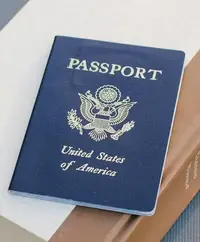
When you arrive at customs in Peru, you will likely be asked for your passport, proof of onward transportation, your intended length of stay, and the address of your first accommodation. You can verbally communicate your length of stay and where you’ll be staying to the customs officer (if you’re staying at multiple locations, simply mention the first one). If you are a U.S. citizen planning to stay for less than 183 days, you will not need a visa, but you will need a valid passport that is good for at least one day beyond your entry date and has at least one blank page for a stamp. You will also need to provide proof of your departure from the country, which is most easily done by showing your return flight ticket if you purchased a round trip flight. Alternatively, a pre-purchased bus or flight ticket out of Peru can serve as proof of onward travel.
You may also need proof of economic means. Unless there is a highly unusual suspicion that you cannot affort your stay in Peru, you will likely not be asked to show proof. Tourists from U.S.A, Canada, and Europe likely will not be asked. If you are unlucky enough to be asked for proof of economic means, you may show the customs official proof of prepaid lodging and transportation, as well as any cash or credit cards you have with you. You can also present a bank statement showing sufficient funds, however, it is unlikely that this would be required. For more official information for U.S. travelers, please visit the U.S. Embassy in Peru, the U.S. State Department, or the Government of Peru: Essential information for tourists in Peru.
If you are going to leave Peru for a neighboring country, be sure to go through an Immigration control post to register your departure. Failing to do so is against the law.
Disclaimer: It is essential to conduct your own research using official and reliable sources to determine the travel documentation required for your specific circumstances and travel dates. The information provided above may not be accurate for your situation and could be outdated.
Safety
Peru is generally considered a safe destination for travelers, with a U.S. State Department travel advisory level of 2, which encourages visitors to "exercise increased caution." This advisory highlights some risks but is not a recommendation against travel to the country. Most visitors have a trouble-free experience, especially in well-visited areas like Cusco, Lima, the Sacred Valley, and the ecolodges of the Amazon basin. However, travelers should be aware of specific regions where safety risks are higher. The U.S. State Department advises against travel near the Peru-Colombia border in Loreto and within the Valley of the Apurímac, Ene, and Mantaro Rivers (VRAEM) due to coca production and the presence of terrorist groups, which may present a threat to safety.
Travelers should stay vigilant, as crime, including petty theft, carjackings, muggings, and occasional assaults, can occur even in broad daylight, particularly in crowded tourist areas. Though kidnappings are rare, organized criminal groups have been reported to use roadblocks in remote areas outside of Lima to target unsuspecting travelers. The risk of crime generally increases after dark, so avoiding walking alone at night, especially in unfamiliar areas, is recommended. By taking standard precautions, such as securing valuables, avoiding isolated areas, and using trusted transportation options, travelers can significantly reduce their risk and enjoy a safe experience in Peru.
Vaccinations for Traveling to Peru
When planning a trip to Peru, it's important to consider the recommended vaccinations to ensure a safe and healthy journey. According to the Centers for Disease Control and Prevention (CDC), travelers should be up to date on routine vaccines, such as measles-mumps-rubella (MMR), diphtheria-tetanus-pertussis, varicella (chickenpox), polio, and the yearly flu shot. Additionally, vaccines for Hepatitis A and Typhoid are recommended due to the risks posed by contaminated food or water in Peru. For those traveling to regions where there is a risk of yellow fever, such as the Amazon Basin, the Yellow Fever vaccine is strongly recommended and may be required for entry into the country (customs were not requiring vaccine proof at the time that the author visited Peru in December 2024). The CDC also suggests considering vaccines for Hepatitis B, Rabies (especially if working with or around animals), and Malaria prophylaxis depending on the specific areas you plan to visit within Peru. For detailed and updated travel health recommendations for Peru, please refer to the CDC’s website.
Personal Experience and Recommendations
Based on my personal experience traveling to the Peruvian Amazon, I strongly recommend that travelers at least get vaccinated against Hepatitis A, Yellow Fever, Tetanus, and Typhoid (in addition to any vaccines recommended for your home country). These vaccines are relatively affordable and are typically effective soon after administration with minimal side effects. Considering the severe consequences of contracting these diseases, these vaccinations offer a valuable precaution. For those hesitant about the upfront costs of vaccinations, consider that most vaccines provide long-lasting protection, often for many years or even a lifetime, making them a one-time investment that won't be necessary on subsequent trips.
Additionally, I recommend purchasing and packing medication for travelers' diarrhea, which can result from bacterial, parasitic, or viral infections, but might also occur simply due to dietary changes. Anti diarrheal medications such as ZITHROMAX (azithromycin) can be purchased beforehand and carried during the trip to be used as needed, or saved for future travels if they remain unused.
Travelers often have mixed opinions about malaria pills. These are generally expensive and can have side effects. While malaria is present throughout the Amazon, and the CDC's yellow book labels the entire Amazon region as being high risk, Malaria can be highly localized, meaning the risk varies significantly depending on the exact travel destination (even within the Amazon basin). Therefore, travelers should attempt to find out if malaria is common in the areas they are traveling to or through, if possible. Regardless of the presence of malaria or other mosquito tramsmitted diseases, travelers should take precautions to minimize exposure to mosquito bites. Mosquito prevention measures such as using DEET-containing repellents and treating clothing and gear with permethrin (available at outdoor outfitters like REI or the camping sections of big-box stores like Walmart) are essential.
The need for the rabies vaccine (pre-exposure prophylaxis) often sparks debate among travelers due to its perceived low risk. Most people, world-wide, are unlikely to be exposed to rabies, and exposure is not necessarily more likely while traveling than it is at home. Most people, therefore, opt out of pre-exposure prophylaxis. However, rabies is extremely serious and nearly always fatal once symptoms appear, requiring immediate post-exposure treatment—even for vaccinated individuals. The main drawbacks of the vaccine include its cost, the inconvenience of receiving three doses, and it doesn't eliminate the need for immediate post-exposure treatment. Ultimately, whether to get vaccinated against rabies depends on one's personal risk tolerance and specific travel plans. Travelers who handle bats, work closely with potentially rabid wild mammals or dogs will have a higher risk and should consider it essential and discuss their risks with a healthcare provider.
It’s important to note that the above recommendations are based on my personal (nonprofessional) experience, research, and risk tolerance, and may not reflect the views of the CDC or the broader medical community. All travelers should conduct their own research, consult resources like the CDC and World Health Organization (WHO) websites, and seek advice from a specialized travel clinic (such as Passport Health in the U.S.) which offers expert guidance tailored to specific travel destinations. Ultimately, the choice of what precautions to take are up to you and depend on your own risk tolerance.
Pro tip: Often, pharmacies can provide some medications at lower costs than travel clinics can, and some vaccinations, especially non-travel specific vaccines such as flu or covid can be obtained cheaper or free at pharmacies, walk-in clinics, or in-network health providers.
Travel Insurance and Health Considerations
When planning your trip to Peru, it’s crucial to consider travel insurance and health-related preparations to ensure a safe and worry-free experience. Although Peru is generally a safe destination, unforeseen circumstances such as accidents, illness, or travel disruptions can occur anywhere. The country's healthcare system is underfunded, and the quality of care can vary significantly outside of major cities like Lima. Tourists visiting remote regions should be aware of the travel time to the nearest hospital and have a plan for accessing emergency medical assistance. Wildlife adventurers in the Amazon basin, for example, should be prepared for transportation to medical facilities in case of injuries like venomous snake bites.
Securing comprehensive travel insurance that covers medical expenses, trip cancellations, and other potential issues provides peace of mind and is highly recommended, even for budget travelers. Travel insurance is relatively inexpensive and should be considered essential for all travelers. I personally use Allianz travel insurance. While I’ve been fortunate never to have made a claim and thus cannot speak to the claims process, acquiring the insurance was straightforward and affordable, offering excellent coverage and benefits. They also provide a concierge telephone service that can assist with disrupted travel plans and offer advice on entertainment, accommodations, currency exchange, and more.
Can You Drink the Tap Water in Peru?
In Peru, drinking tap water is not recommended for visitors due to contamination concerns related to inadequate sanitation infrastructure and pollution. The water supply in Peru can carry harmful contaminants, including bacteria, parasites, and, in some areas, heavy metals from mining activities. Even in Lima, the tap water remains unsafe for consumption. Despite recent improvements, contamination issues stemming from outdated infrastructure make it advisable for visitors to avoid drinking tap water directly. Consuming untreated water can lead to gastrointestinal issues such as cramps, diarrhea, and nausea, potentially disrupting travel plans.
Similarly, in Cusco, a popular tourist hub known for its rich history and proximity to Machu Picchu, the water quality poses risks due to infrastructure limitations. Water here may not meet international standards, making it susceptible to harmful bacteria and parasites. To avoid waterborne illnesses, travelers should also avoid brushing their teeth with tap water; instead, use bottled or filtered water. When in Peru, consider using sealed bottled water from reputable brands, but be aware of the environmental impact of single-use plastic. Alternatively, a filter water bottle with built-in filtration capabilities is a sustainable solution that provides portable access to safe drinking water. These bottles filter out bacteria, parasites and other harmful contaminants, making them ideal for travel. Some, but not all, filters can even filter out viruses. However, no commercially available filters will filter out heavy metals.
While boiling or filtering water is a reliable way to make it safe for drinking, it’s generally unnecessary to worry about water exposure during showers. However, those with sensitive stomachs may prefer using filtered or boiled water to brush their teeth and rinse fruits and vegetables. Many hotels provide bottled water or filtered water stations for guests, offering convenient options for staying hydrated safely.
Food: Groceries and Restaurants
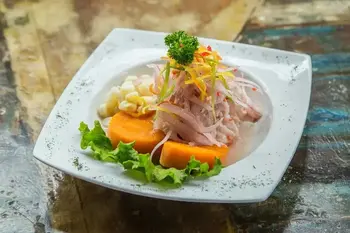
Grocery shopping in Peru offers a mix of familiar supermarkets (supermercados in Spanish) and local markets, allowing travelers to find a wide range of products, from imported goods to fresh local produce. In major cities like Lima and Cusco, popular supermarket chains like Wong, Plaza Vea, and Metro carry a variety of foods, household items, and international products. These stores offer a familiar shopping experience for visitors, though imported goods may come at a premium. Outside the larger cities, smaller tiendas or local markets become more common, selling fresh fruits, vegetables, and basic pantry items at much lower prices. Shopping at these local markets provides both a budget-friendly option and an opportunity to experience Peru’s rich agricultural diversity firsthand.
Overall, the cost of groceries in Peru tends to be lower than in the U.S., especially for local products. Essentials like rice, potatoes, fruits, and vegetables are often significantly cheaper, given Peru’s agricultural abundance. However, imported goods and luxury items can be pricier than in the U.S. due to import taxes. For example, fresh produce like bananas, avocados, and mangoes, which are locally grown, are usually very affordable, while imported dairy products, packaged snacks, and international brands of toiletries may cost more than what visitors from the U.S. are used to. Generally, travelers will find they can save considerably by purchasing local staples and produce, making grocery shopping in Peru an affordable experience, especially for those who don’t mind forgoing imported products.
Dining out in Peru offers a variety of experiences that cater to all budgets, from affordable street food to upscale dining. Local eateries, known as cevicherias and pollerias, serve popular Peruvian dishes like ceviche, pollo a la brasa (rotisserie chicken), and hearty soups, typically at very reasonable prices. In small neighborhood restaurants, a typical set menu, called menu del día (menu of the day), usually includes a starter, main dish, and beverage, costing around 10–20 soles ($3–$6 USD). This is an economical way to try authentic Peruvian food without breaking the bank. Mid-range and high-end restaurants, especially in cities like Lima, Cusco, and Arequipa, can be pricier, often approaching prices similar to those in the U.S., but they also provide a more refined dining experience with modern interpretations of traditional flavors.
It is generally safe for American and European tourists to eat at restaurants in Peru, particularly at reputable establishments and in well-traveled areas. Many restaurants in cities like Lima, Cusco, and Arequipa adhere to high hygiene standards, especially in popular tourist zones. However, travelers should exercise normal caution when dining at smaller, local eateries or street food stalls, as food safety practices can vary. To minimize the risk of foodborne illness, avoid raw or undercooked foods outside of trusted restaurants and be cautious with fresh salads and unpeeled fruits, which may have been washed in untreated water. Choosing well-cooked dishes and dining at places with good reviews or high foot traffic can help ensure a safe and enjoyable culinary experience in Peru. Travelers with sensitive stomachs should be cautious when eating at small restaurants—not necessarily due to food contamination, but because a sudden change in diet can sometimes lead to stomach upset or diarrhea.
Packing Tips for Ecotourists in Peru
In this section, I’ll provide an overview of essential items that wildlife enthusiasts should pack for their trip. For a detailed guide, check out the Peru Gear Guide for Wildlife Photographers.
Peru is a land of remarkable climatic and altitudinal variations. From hot deserts and tropical rainforests to the glaciated peaks of the Andes, Peru encompasses nearly every type of climate imaginable. Packing wisely, based on the specific regions you’ll visit, is essential for a comfortable experience.

Since most herping, birding, and wildlife enthusiasts visit the Amazon Basin, this section focuses on gear for the tropical rainforest. The Peruvian Amazon is a wet environment; if you’re there during the rainy season, you can expect frequent downpours, and even in the dry season, rain is common every few days. Staying completely dry while hiking in the hot, humid lowlands is nearly impossible, as you’ll likely be drenched by rain, sweat, or from brushing against wet foliage. However, the warm temperatures mean hypothermia is rarely a concern, so the goal is to stay comfortable even when wet. I highly recommend wearing synthetic fabrics or wool, which dry faster than cotton and are more comfortable when damp, as cotton can take days to dry in high humidity.
Every hiker should carry a lightweight, packable poncho. Ponchos are inexpensive, compact, and provide quick coverage from sudden downpours. While the rainforest heat often makes getting rained on tolerable, a poncho is invaluable during torrential downpours that are common in the rainy season. To protect your camera gear, electronics, passport, and money, use a dry bag and add smaller items to plastic sealable bags within your pack. Large yard waste bags are also helpful for covering suitcases and luggage in the event of a sudden downpour.
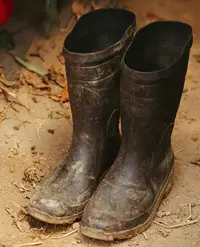
Rubber boots are essential for rainy season hikes in the rainforest. I recommend pairing them with knee-high, thin wool socks, which prevent the boots from rubbing and allow you to wear shorts for breathability while keeping your legs protected. Wool socks dry quickly and insulate better when wet. Alternatively, long pants tucked into the boots work well, provided you use sturdy ankle-high socks. At higher elevations, such as the cloud forests and the Andes, where the air is cooler, it’s easier to stay dry, and you’ll want to prioritize warmth. Synthetic fiber clothing and a reliable poncho or rain jacket will help you stay comfortable. Rubber boots may not be necessary on popular, well-maintained cloud forest trails but can be helpful in muddy conditions, especially during the rainy season.
Remember essential items like toiletries, sunscreen, mosquito repellent, and spare batteries. Sunscreen and insect repellent may be costly and hard to find, especially outside larger cities. Also, bring specialized items like camera batteries, memory cards, and accessories specific to your gear, as camera stores may not be readily available in remote areas.
Finally, flashlights are essential. In Peru’s tropical latitude, you’ll have roughly 12 hours of darkness each day, and primary forest canopies block most natural light, making visibility extremely limited without artificial light. I highly recommend carrying two flashlights: a headlamp for hands-free use and a handheld LED light, along with spare batteries and chargers. Having reliable lighting is vital; you won’t want to be without it in the rainforest.
Electrical Outlets in Peru
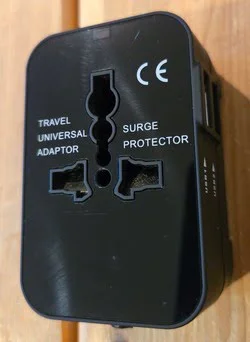
In Peru, electrical outlets typically supply 220 volts at 60 Hz, which differs from the standard 110 volts in the United States. Peruvian outlets usually accommodate two types of plug shapes: Type A (two flat, parallel pins) and Type C (two round pins), though Type C is more common. American travelers should bring a universal adapter that can fit these plug types and handle the higher voltage. Many universal adapters come with built-in voltage converters. This preparation will ensure that electronics, from phones to laptops, can be safely used throughout Peru.
Packing Camera Equipment for Peru Wildlife Photography
In this section, I’ll provide a brief overview of the essential camera equipment to bring to Peru. For a more detailed discussion, please refer to the Camera Gear for Peru page. All photographers should bring several camera batteries and chargers, as well as multiple data storage cards. This isn’t just because you’ll be taking lots of photos, but also as a safeguard against theft, damage, or malfunctions. Spreading your photos across multiple cards ensures you don’t lose everything at once. Additionally, a flash is a must-have in the rainforest. Even during the day, overcast skies and dense canopies can significantly reduce ambient light, making a flash essential, especially for macro photography.
Herpetology Photography

If you’re focusing on reptiles, amphibians, and invertebrates, you’ll want to bring a macro lens and/or a wide-angle lens for close-up shots, a flash, and a flash diffuser. Even if you prefer natural light photography, the low light levels in the forest often make flash photography necessary to capture clear, detailed images.
Birding Photography
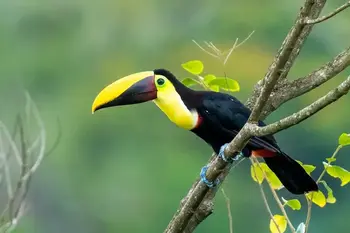
Birding in Peru will require the same lenses and tripods you typically use for bird photography. However, the low light conditions you’ll likely encounter in the Peruvian Amazon mean you may need faster lenses to capture as much light as possible. You might also consider adding a flash to your setup to improve your chances of getting the perfect shot.
General Wildlife Photography
For general wildlife photography, whether you’re looking to capture sloths, toucans, or reptiles and amphibians, a long lens is essential for birds and mammals, while a macro and/or wide-angle lens is ideal for closer subjects like reptiles, amphibians, invertebrates, and plants. A flash with a diffuser is usually necessary for macro photography in the rainforest, even during the day, and a flash without the diffuser can be used with the long lens. For a long lens, I recommend a 400mm or 500mm prime lens. The advantage of fixed focal length prime lenses, such as the Nikon 500mm PF lens (f/5.6), is that they are weather-sealed (perfect for the rainforest) and are lighter and more compact than their zoom lens counterparts.
Cell Phone Use in Peru
Staying connected while traveling in Peru is essential for many visitors, whether for staying in touch with loved ones, navigating the country, or handling emergencies. Fortunately, Peru offers various options for mobile connectivity that cater to different needs and budgets.

Purchasing SIM Cards in Peru
One of the most economical and popular choices for tourists is to buy a local SIM card upon arrival. This allows you access to local rates for calls, texts, and data. Major telecommunications providers in Peru include Claro, Movistar, Entel, and Bitel all offering competitive coverage and rates. SIM cards can be purchased at major airports like Jorge Chávez International Airport in Lima, where you'll find kiosks in the arrivals hall. Kiosks and stores can also be found in most market places in most towns throughout Peru. To purchase a SIM, you’ll need to show your passport, and it's advisable to ensure your phone is unlocked before your trip.
What is an unlocked phone? An unlocked cell phone can be used with multiple service providers, while a locked phone is tied to a specific carrier. Unlocked phones are more flexible and can be used with any compatible network, including international carriers. To find out if your phone is locked or unlocked, you can check your phone's settings. For example, on an iPhone, you can go to Settings, then Cellular, then Cellular Data. If you see "Cellular Data Network", your phone is probably unlocked. You can also consult your carrier's unlocking policy for more information.
The main advantage of a local SIM is cost efficiency; using local network rates is significantly cheaper than international roaming charges. The downside is that it requires an unlocked phone, and you might have to deal with language barriers when purchasing the SIM or needing assistance.
Burner Phones
For those who prefer not to use their personal devices or need a temporary phone solution, burner phones (cheap prepaid cell phones with no commitments or contracts required) are available for purchase. These can be found in many of the same places as SIM cards, including most market places in most towns throughout Peru. Burner phones provide basic functionalities and are pre-loaded with a set amount of calling and texting capabilities, making them a secure and straightforward option. Burner phones provide a degree of privacy and simplicity, ideal for travelers who may not want to use their personal device overseas. However, they can be limited in functionality and might not include data service, which is a drawback for those needing internet access on the go. They also don't have all the apps, files, and functionalities that you're used to having on your personal phone.
International Plans
For travelers from the United States, particularly those already using AT&T, the AT&T International Day Pass is highly recommended. This plan allows you to use your current plan in Peru for $10 per day (as of 2025), charged only on the days you use it. This option is perfect for those who need to stay connected with their usual number and service but don’t want the hassle of changing SIM cards. It offers convenience and reliability, though it can be more costly compared to local SIM cards if used extensively.
Personally, this is the option I use when traveling abroad. I mostly just use cell/data service when I am traveling from one in-country destination to another, so that I can use my phone to call home, call the lodge I am staying at, use navagation apps, and access the internet. When I'm not travelling, I'll just remove my SIM card and place it in the safe waterproof pouch I keep my passport in, so that I can still use my phone for photos and other apps not requiring cell or data service, and not worry about accidentally triggering the daily fee.
Transportation to and Within Peru
Traveling to and around Peru offers unique logistical challenges, as the country’s diverse geography creates certain limitations for road travel. The distance between major cities, such as Lima and Cusco, is vast, making air travel the most practical option for many visitors. The Andes mountain range acts as a natural barrier between the eastern and western regions of Peru, often requiring travelers to navigate winding mountain passes when journeying overland. In the Amazon Basin, where dense rainforests and rivers dominate, boat travel is the primary means of transport. Understanding these geographical factors can help travelers plan efficient and enjoyable routes across Peru’s varied landscapes.
International Travel
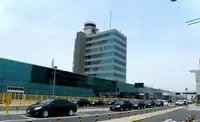
International travel to Peru is primarily through Jorge Chávez International Airport (LIM) in Lima, which serves as the country’s main gateway for international flights. From Lima, travelers can connect to several key domestic destinations. For those headed to Machu Picchu, flights are available to Cusco, while visitors to the Amazon Basin can fly to Iquitos in the northern Amazon or Puerto Maldonado in the southern Amazon. These domestic flights make it convenient to access Peru’s diverse regions from the capital, allowing travelers to efficiently explore both the highlands and the rainforests.
Ground Transportation: Car Rentals vs. Bus
If you’ve decided on ground transportation, the next decision is whether to rent a car or rely on buses and taxis. Buses and taxis are very affordable, reliable, and serve nearly every town in Peru, no matter how small. Renting a car is convenient, quick, and provides ultimate freedom in travel, however, it is likely to be considerably more expensive than bus/taxi, even when taking frequent taxi rides.
Pros and Cons of Bus Travel
Bus travel in Peru is a popular and affordable way to explore the country’s diverse regions, offering both convenience and cultural immersion. For travelers on a budget, buses provide a cost-effective alternative to flights, with well-established companies like Cruz del Sur, Oltursa, and Tepsa operating comfortable, modern coaches with amenities such as reclining seats, air conditioning, and on-board entertainment. Peru also has a unique hop-on-hop-off service called Peru Hop, which is specifically designed for tourists, allowing flexibility to visit key destinations along the Lima-to-Cusco route. Long-distance buses also provide scenic views of the Peruvian landscape, including dramatic coastal cliffs, verdant valleys, and breathtaking Andean mountain passes, making the journey part of the adventure. Daytime buses are ideal for sightseeing, while overnight buses help save on accommodation costs, especially useful for travelers on extended itineraries.
However, bus travel in Peru also comes with challenges that may be a drawback for some visitors. Long travel times, such as the 20-hour journey from Lima to Cusco, can be taxing, especially on less luxurious, local buses that make frequent stops. Additionally, winding roads through the Andes, combined with aggressive driving habits of some local drivers, may make travel uncomfortable or even nerve-wracking for those unfamiliar with mountainous terrain. Safety can be a concern, as reports of petty theft and road accidents exist, so travelers are advised to keep valuables on them and choose reputable bus companies for long journeys. For those planning to travel by bus in rural or Amazonian areas, it’s also important to note that not all routes are paved, which can make for rough rides and occasional delays (Note that the Amazonian city of Iquitos is not accessible by road at all). Despite these potential drawbacks, bus travel in Peru remains a reliable option for those seeking an economical and immersive way to experience the country.
Pros of Bus Travel in Peru:
- Cost-effective for long-distance travel, especially for budget-conscious travelers
- Well-established bus companies offer comfortable amenities (e.g., reclining seats, Wi-Fi, on-board entertainment)
- Peru Hop provides a flexible, hop-on-hop-off experience tailored to tourists
- Opportunity for scenic views of coastal, Andean, and rural landscapes
- Daytime buses allow for sightseeing, and overnight buses save on accommodation costs
Cons of Bus Travel in Peru:
- Long travel times for cross-country routes
- Winding mountain roads and aggressive driving can make travel uncomfortable
- Safety concerns, including petty theft and occasional road accidents
- Rough, unpaved roads in rural and Amazonian regions can cause delays
- Frequent stops on local buses may add to travel time
Pros and Cons of Car Rentals
Renting a car in Peru can provide flexibility and the freedom to explore diverse landscapes, but it requires careful consideration due to the unique challenges of driving there. Peru’s driving conditions, particularly in bustling cities like Lima, may be more intense than what many travelers are used to, with aggressive drivers, unpredictable traffic, and pedestrians crossing without warning. Car rentals are available in Lima, Cusco, Arequipa, and Piura, and it’s advisable to rent from reputable international companies such as Alamo, Avis, Hertz, and Europcar, as they tend to maintain higher vehicle standards and offer clearer pricing agreements. Smaller companies may have unexpected charges or unclear terms, so be sure to read the rental agreement closely for any extra fees, mileage limits, or insurance details.
For those considering longer drives, such as from Lima to Cusco, a 4-wheel drive vehicle is recommended, especially when navigating mountain passes in the Andes. Compact cars typically rent for around $20–$40 USD per day, while SUVs or trucks suitable for mountainous terrain cost around $50–$70 USD per day. If you’re planning on picking up a rental in Lima, it’s generally best to avoid driving straight from the airport due to the challenging traffic; instead, arrange for the rental to be delivered to your hotel, or pick it up from a more convenient location. When driving on major highways, like the Pan-American Highway, travelers should also expect tolls, which only accept cash.
Driving in remote areas of Peru adds further considerations. Mobile reception can be limited, so renting a GPS unit (around $5–$10 USD per day) is highly recommended for rural travel. Fuel costs are also an important factor, as gas prices in Peru are approximately $5 USD per gallon, and full-service attendants at gas stations may expect a small tip. While basic insurance is usually included in rental estimates, the coverage is minimal, and upgrading to a higher level is advisable, especially for those unfamiliar with driving in Peru. With enhanced insurance, a first-aid kit, spare tire, and required documents (license, passport, and rental agreement), renting a car in Peru can be a rewarding way to explore scenic landscapes and make spontaneous stops—though it’s best suited to confident, prepared drivers.[2]
Pros of Car Rental in Peru:
- Freedom to go wherever you want, even off main bus routes.
- Easiest way to make frequent short trips to restaurants, supermarkets, etc.
- Freedom to make stops and detours on road trips.
- Road cruising for wildlife.
- No need to wait at airport or bus terminals.
- Avoiding sharing space with strangers.
Cons of Car Rental in Peru:
- More expensive than bus and certain flights.
- Increased travel time, compared with flying (e.g. Lima to Cusco is 2hr by plane and 20 hrs by car)
- Driving amongst aggressive drivers.
- Dishonest companies overcharging you, or surprising you with hidden charges.
- Steep, winding, narrow, mountain roads.
- Poorly maintained rural roads.
Car Rental Requirements in Peru:
- Passport (valid)
- Valid Driver's License from Home Country (International driver's license not required when renting for less than 6 months)
- Credit Card with Funds Available for Security Deposit
- Minimum Age (21-25) Dependent on Company
- No photocopies of documents are acceptable.
- Make sure you don't accidentally reserve a manual transmission vehicle if you cannot drive manual transmission.
- Don't believe advertised prices that are too good to be true. A reputable company is better than a bargain company (and, ironically, often the same final price).
- Carry coins (in local currency, Soles) for tolls and parking attendants.
- Use local currency (Soles) or credit card for gas.
Domestic Flights
Domestic flights within Peru offer a fast and efficient way to navigate the country’s challenging geography, providing a convenient alternative to long bus rides and winding mountain roads. Given the vast distances and rugged landscapes that separate key destinations, such as Lima and Cusco or Cusco and Iquitos, flights are often the most practical option for those on a limited schedule. Major airlines like LATAM, Sky Airline operate numerous routes throughout the country, connecting travelers to popular tourist destinations in under two hours, whereas bus rides between these locations can take over 20 hours. For visitors interested in exploring both the Andes and the Amazon, flying offers the flexibility to see diverse ecosystems without extended travel times, allowing them to maximize time spent at their destination rather than in transit.
Peru’s network of airports supports travel to both popular and remote areas, making it easier to access regions with limited road infrastructure. Jorge Chávez International Airport (LIM) in Lima serves as the main hub for domestic flights, with frequent connections to Cusco’s Alejandro Velasco Astete International Airport (CUZ) for travelers headed to Machu Picchu. Other prominent airports include Rodríguez Ballón International Airport (AQP) in Arequipa, offering access to the Colca Canyon, and Coronel FAP Francisco Secada Vignetta International Airport (IQT) in Iquitos, which is ideal for travelers exploring the Amazon Basin. In the southern Peruvian Amazon, Padre Aldamiz International Airport (PEM) in Puerto Maldonado provides entry to the region’s renowned rainforests and wildlife. Domestic flights, though more expensive than bus tickets, are time-saving and offer the added benefit of connecting remote locations, making them an advantageous option for travelers looking to see as much of Peru as possible within a short period.
Taxi
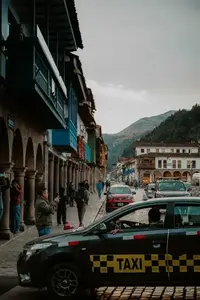
Taxis are a common and convenient form of transportation in Peru, especially for navigating cities and shorter distances. They are widely available in urban areas like Lima, Cusco, and Arequipa, where they provide a flexible option for travelers who want to move at their own pace without relying on bus schedules or navigating Peru’s challenging roads. Taxi fares vary depending on the city, distance, and type of service. In Lima, a short trip within the city center may cost around 10–20 soles ($3–$6 USD), while longer journeys, such as from Lima’s airport to Miraflores, might cost 50–70 soles ($15–$20 USD). Unlike in many countries, taxis in Peru do not use meters, so fares are negotiated in advance. Taxi drivers will usually try to overcharge tourists, so be sure to find out beforehand what a fair price for your ride should be, and then make sure to haggle with the driver or be prepared to reject the driver's offer and find a different cab. Tipping is not necessary or expected. If negotiating cab fares is not to your liking, other options like Uber or Cabify offer set prices and additional safety features.
While taxis are convenient, they come with some advantages and disadvantages compared to other travel options. On the plus side, taxis offer door-to-door service, which is especially useful when transporting luggage or navigating crowded areas. They are also widely accessible, reducing the need for planning in advance. However, the lack of metering and the variability in fare negotiation can make it challenging for tourists unfamiliar with local pricing. Additionally, there are occasional reports of overcharging or, more rarely, safety concerns, so it is generally safer to avoid unmarked or unofficial taxis. In Peru, real taxis are typically marked with company logos, official stickers, and a registration number on the windshield, while fake taxis often lack these identifiers and may not display proper signage. Compared to buses or domestic flights, taxis are better suited for short, city-based travel rather than cross-country trips, as costs can add up quickly over long distances. For travelers seeking affordable, reliable, and short-distance transportation, taxis offer a valuable option, but choosing reputable services or apps is recommended to ensure a smooth experience.
Bus
Peru offers a wide range of bus travel options that make it easy and affordable to journey between cities. Many Peruvians rely on buses for intercity travel, and tourists can typically purchase tickets the day before or even the day of travel. To get the best price, it’s often advisable to buy directly from the bus company at the terminal, as purchasing through agents may include a markup for commission. For tourists interested in a flexible, hop-on-hop-off travel experience, Peru Hop caters specifically to travelers, connecting major tourist destinations rather than just city-to-city routes. Companies like Peru Hop and Cruz del Sur focus on traveler safety and are safer options than taking smaller, regional bus companies.
Within cities, small local buses and vans, known as colectivos, connect travelers to nearby towns and neighborhoods. Colectivos typically display their route on the side of the vehicle, and fares usually range from S/1 to S/4 ($0.26 - $1.06 USD), posted inside the bus. Payment is often made upon exiting, and each colectivo has an assistant who collects fares. For intercity travel, travelers looking for a basic, low-cost experience can opt for local buses that operate directly from smaller offices and stop frequently along their routes. However, for a more comfortable experience with assigned seating, baggage handling and checking (for increased luggage security), and optional onboard amenities, larger companies like Cruz del Sur, Oltursa, Tepsa, Civa, and Movil offer reliable, scheduled service across Peru, including both daytime and overnight routes. Daytime buses offer scenic views, while overnight options can help save on accommodation costs.
Traveling safely. While violent crimes are uncommon, bus travelers should be extra vigilant to avoid petty theft. Passports and other valuables should be kept on your person, regardless of whether your bags were checked or not. Keep an eye on your luggage, and if you have stowed luggage, keep an eye out for possible thieves when the bus stops (consider choosing a window seat on the side of the bus with the luggage doors).
Major Bus Companies Departing Lima
Peru Hop is designed for travelers who want more than the typical tourist experience. Founded by Irish owners in partnership with locals, this hop-on, hop-off bus service connects Lima and Cusco/Machu Picchu, allowing travelers to explore Peru’s highlights at their own pace. Unlike standard buses or flights, Peru Hop includes stops at hidden gems along the way, giving riders an authentic look at Peruvian culture and landscapes. Each bus has local hosts who share fascinating stories about Peru, adding depth to the journey. With one flexible ticket, travelers can independently hop on and off at various cities and towns, creating their own itinerary or deciding as they go.
Cruz del Sur is a highly respected Peruvian bus company, known for its modern, comfortable fleet that ensures a pleasant travel experience. Operating for over 63 years, Cruz del Sur serves more than five million customers with routes to 22 destinations across Peru. This 100% Peruvian company offers single and double-decker luxury buses with fully reclining seats, making it ideal for both short trips and long-distance travel. Their state-of-the-art buses are designed to provide a smooth, quiet journey, and the company’s commitment to comfort and reliability has made it a popular choice among locals and tourists alike.
Airport Express Lima provides a safe, reliable, and comfortable bus service connecting Lima’s Jorge Chávez International Airport to the popular districts of Miraflores and San Isidro. Launched in March 2017, this service fills a crucial need for secure transportation, especially given the challenges of navigating the busy airport area, which is located in Callao—one of Lima’s less safe districts. Airport Express Lima buses run every hour and offer 12 official stops within Miraflores and San Isidro, conveniently close to numerous hotels and hostels. With modern 40-seat coaches equipped with on-board Wi-Fi, USB ports, reclining seats, and TVs, passengers can relax on their way to the city. Tickets are available online or at the airport, with one-way fares priced at $8 USD (25 soles) and round-trips at $15 USD (48 soles), making Airport Express Lima an affordable and comfortable option for travelers.[1]
| Bus Stations and Routes from Lima | ||||
| Destination City | Bus Companies | |||
| Arequipa | 1. Peru Hop 2. Cruz Del Sur 3. Transmar 4. Palomino | |||
| Cusco | 1. Peru Hop 2. Cruz Del Sur 3. Transmar 4. Palomino | |||
| Trujillo | 1. Cruz Del Sur 2. Transmar 3. Palomino | |||
| Chiclayo | 1. Cruz Del Sur 2. Transmar 3. Palomino | |||
| Cajamarca | 1. Transmar 2. Palomino | |||
| Huacachina | 1. Peru Hop | |||
| Puno | 1. Peru Hop | |||
Additional Bus Resources
For information on bus routes, bus companies, and general Peru travel information, visit The Only Peru Guide.
For information on bus routes, including routes requiring transfers,Rio 2 Rome is an invaluable resource. Just type in your starting point and destination, and then select the bus option. Use Rio 2 Rome to find the bus route, the terminal name, and its location on a map.
Exploring Peru:
A Guide for Wildlife Enthusiasts
Peruvian Amazon
Aside from Machu Pichu and Peru's destination cities such as Lima and Cusco, the main attraction to tourists, and especially ecotourists is the Peruvian Amazon. Peru’s Amazon Basin is a haven for wildlife enthusiasts, with many ecolodges and tour companies that cater to wildlife photographers and ecotourists. Peru's Amazon rainforest is extremely vast and the aspiring ecotourist may feel overwhelmed at where to begin to search for the correct region to visit. However, it's more simple than you might imagince by staring at a map. Tourists to the Peruvian Amazon typically enter via three main regions: Iquitos, Manau National Park, or the Tambopata region. Let's breifly discuss each region.
Iquitos is a city in North East Peru, within the Amazon rainforest, and along the Amazon River. Iquitos is inaccessible to the outside world by road and is typically accessed via a flight from Lima. If you are looking to explore the Amazon rainforest and the actual Amazon river, this is the region for you. Reasonably priced and frequent flights on large commercial jets are available from Lima. Several ecolodges and tour operations, such as Otorongo ecolodge are available in the region, and typically include transportation from and to Iquitos. Although some public land exists in this region, most access to the rainforest is on private reserves and ecolodges. Treks into public land is almost always with a private guide.
Manu National Park is located in the southern part of Peru's Amazon basin and is typically accessed from the city of Cusco in the south of Peru and within the Andes. Although Manu is a national park, tourists don't have the same freedom to hike freely and camp throughout the park as you would in a national park in the U.S.A. Rather, tourists usually enter the park as part of a guided tour, run by a private company. These private tour companies offer exclusive tours, providing all transportation from Cusco, accommodations, and food. Although Manu is within the Amazon rainforest, it does not contain the actual Amazon river, so if visiting the Amazon river is of primary importance, you should consider Iquitos. You can read more about Manu National Park in the next section.
The third main access point for tourists to the Peruvian Amazon is the Tambopata region in the south east corner of the country and the Amazon Basin. This region is accessed from the city of Puerto Maldonado, located on the Madres de Dios river. From Puerto Maldonado, tourists have options for several private ecolodges and preserves down river, which often provide transportation between the lodging and Puerto Maldonado. Guiding companies can also take tourists on day trips down the river and to public, protected rainforest lands, such as the Tambopata reserve. The Tambopata region offers ecotourists with many options to visit and stay within the Amazon rainforest, with all the species and biodiversity you expect from the Amazon basin. Just like Manu, however, this region doesn't have access to the actual Amazon river. To visit the Amazon river, you'll have to visit the Iquitos region. You can read more about the public lands of Tambopata in the next section.
The Peruvian Amazon basin, offers many protected areas teeming with biodiversity. From strictly regulated national parks to more flexible nature reserves and buffer zones, each type of public land presents its own set of rules for trail access, camping, and trekking. In the next section, you will find an overview of the main protected lands in Peru’s Amazon region, as well as other areas with fewer restrictions, to help visitors navigate the best spots for immersive and responsible wildlife exploration.
Protected Lands in Peru’s Amazon Basin: National Parks and Nature Reserves
This section discusses the protected national lands within Peru's Amazon basin. For North American visitors who are used to enormous amounts of freedom to hike, explore, and camp within national public lands, you may be somewhat dissapointed with the lack of freedom for public access to lands. Peru typically doesn't offer the same freedoms that the U.S. and Canada does to public lands. However, don't let this discourage you. The truth is, you may not require the same level of freedom, due to the natural difficulty in accessing this region. The Amazon rainforest is extremely difficult to physically access due to impenetrable jungle, lack of roads and trails, the need for boat travel, and the extreme challenges of navigating and staying safe within the forests. Unlike hikes in the forests of North America's mountainous regions, the Amazon rainforest is much more difficult to walk through due to thick vegetation, lack of trails, and seasonally flooded forests. The rainforest can also be extremely difficult to navigate due to a lack of geological features as reference points, closed canopies that obscure the sun and stars, and due to a very limited line of site. In short, the lack of freedom for self exploration in Peru's Amazon rainforest is for good reason, and the main obstacle to freely exploring the forest is not due to overly strict regulations, rather it's due to the nature of the forest itself. That being said, we'll discuss the details of public access to Peru's Amazon basin below.
Caution: this section on Peru's Public Lands utilized AI for some of the content and for the Spanish to English translation. There may be mistakes.
The Peruvian government, through SERNANP (the National Service of Natural Protected Areas), manages a variety of protected lands across the Amazon. These include national parks, nature reserves, and wildlife sanctuaries, each with specific regulations to safeguard the ecosystems and provide controlled visitor access.
-
Manu National Park
- Overview: Known for its extraordinary biodiversity, Manu National Park spans several ecosystems, from cloud forests to lowland rainforests.
- Access and Rules: Manu is one of Peru’s most regulated parks. Access is strictly limited to authorized tour operators, and self-guided hikes are prohibited. Visitors must stay on designated trails and be accompanied by certified guides who have in-depth knowledge of the area’s ecology and safety protocols.
- Overnight Stays: Overnight camping is only allowed at pre-established campsites within designated zones, usually as part of organized tours. Independent camping or trekking is not permitted due to strict conservation policies and the need to minimize human impact.
- Best for: Guided, multi-day excursions focused on immersive wildlife viewing.
-
Pacaya-Samiria National Reserve
- Overview: As one of the largest protected areas in Peru, Pacaya-Samiria National Reserve is a prime destination for Amazonian exploration, featuring abundant wildlife and aquatic ecosystems.
- Access and Rules: While Pacaya-Samiria allows more flexibility than national parks, entry still requires permits and is recommended through organized tours. However, some sections are accessible for semi-independent exploration with permission from local communities
- Overnight and Multi-Day Treks: Pacaya-Samiria offers multi-day treks and overnight camping with authorized guides, who facilitate entry permits and help establish temporary campsites. For experienced trekkers, certain trails within the reserve allow for semi-independent hikes, but local guides are still strongly recommended to navigate the often challenging and remote terrain.
- Best for: Multi-day treks along river routes and guided wildlife safaris.
-
Tambopata National Reserve
- Overview: Situated near Puerto Maldonado, Tambopata is well-known for its biodiversity and accessibility for eco-tourism.
- Access and Rules: Tambopata is more flexible than Manu, allowing visitors to explore independently on certain designated trails near lodges. For off-trail exploration, however, guides are required to ensure visitor safety and compliance with conservation practices.
- Overnight Camping: Lodges offer immersive Amazon experiences, but camping options in Tambopata are generally lodge-based. Some community-based initiatives may offer guided camping tours, where visitors can stay in temporary camps in the forest.
- Best for: Lodge-based eco-tourism with short, guided excursions into the forest.
Reserve: Yellow
Buffer: Gray
Public Lands with Fewer Regulations: Buffer Zones and Regional Reserves
Peru also designates certain regions as buffer zones or regional reserves, which are often less restrictive than national parks and reserves. These lands allow for greater flexibility in access and camping, offering experienced and responsible adventurers the chance for more independent exploration.
-
Allpahuayo-Mishana National Reserve
- Overview: Located near Iquitos, this reserve features unique white-sand forests and diverse flora and fauna.
- Access and Rules: Allpahuayo-Mishana allows unguided access on certain trails near the entrance, though it’s still advisable to use local guides. Entry permits may be required, which can be obtained through SERNANP.
- Overnight and Bivouac Options: While official campsites are limited, the reserve is close to Iquitos, allowing for overnight hiking trips with bivouac options in designated areas. Visitors interested in multi-day treks should check with local authorities for regulations on independent camping.
- Best for: Self-guided day hikes or overnight trips with bivouac near trailheads.
-
Cordillera Azul National Park (Buffer Zone)
- Overview: Bordering the Amazon and the Andes, Cordillera Azul’s buffer zone provides breathtaking mountain and forest landscapes and has fewer restrictions.
- Access and Rules: In the buffer zone surrounding Cordillera Azul, unguided hiking and camping are allowed, making it a rare opportunity for self-sufficient, multi-day hikes. However, permits are recommended, and visitors should be aware that these areas are remote, with limited access to emergency assistance.
- Camping and Trekking: With careful preparation, experienced hikers can enjoy multi-day treks with wild camping options. Due to the lack of trails in some areas, however, navigation skills and self-sufficiency are essential.
- Best for: Adventurous, experienced trekkers seeking solitude in remote landscapes.
Park: Green
Buffer: Gray -
Sierra del Divisor National Park (Buffer Zone)
- Overview: Known for its dramatic ridges and pristine rainforest, Sierra del Divisor is one of Peru’s lesser-known parks.
- Access and Rules: Although the park itself is protected, some areas on its outskirts and buffer zones are accessible for independent exploration and camping, especially with local community permission.
- Overnight Options: Multi-day treks with bivouac camping are possible in specific areas of the buffer zone, offering an authentic experience in the wilderness.
- Best for: Remote wildlife viewing and scenic multi-day hikes with bivouac options.
Park: Green
Buffer: Gray
Guidelines for Wild Camping, Bivouac, and Independent Treks in Peru
For adventurers considering unguided, overnight hikes or wild camping, it’s important to understand that Peru’s regulations on public lands vary significantly based on conservation priorities. Wild camping in highly regulated national parks, such as Manu, is generally prohibited. However, in certain regional reserves and buffer zones, limited wild camping is allowed, provided it adheres to Leave No Trace principles
When trekking independently, visitors should be prepared with adequate navigation tools, emergency gear, and knowledge of local wildlife. Bivouac camping is allowed in some buffer zones near reserves but is generally not permitted inside the reserves or parks themselves.
For those planning longer, unguided treks, Cordillera Azul’s buffer zone and Sierra del Divisor’s outskirts offer rare opportunities for adventurous camping. However, remember to respect local guidelines, pack out all waste, and avoid campfires to protect these fragile environments. In areas with few official trails, GPS and topographical maps are essential to ensure safe navigation.
Responsible Practices and Conservation Awareness
Wildlife enthusiasts venturing into Peru’s public lands should prioritize environmental responsibility and conservation. By following guidelines specific to each location, respecting regulations on trail use, and choosing guided tours in more sensitive areas, visitors can help protect Peru’s natural heritage. Whether exploring guided trails in national parks or embarking on independent treks in buffer zones, adhering to conservation practices ensures that Peru’s Amazon and surrounding regions remain unspoiled for future generations.
Ecotourism Etiquette
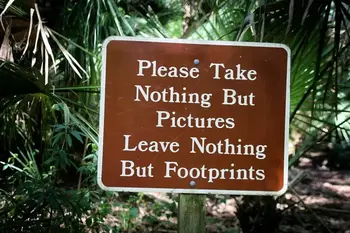
Peru offers ecotourists the rare privilege of immersing themselves in breathtaking natural landscapes and wildlife, a privilege that must be treated with deep respect. As visitors, we have a responsibility to set a positive example, representing our home countries in a way that preserves these opportunities for others. Basic principles of respect apply, such as not littering, damaging, or removing any natural items or artifacts. This includes not disturbing wildlife—many animals are highly sensitive to human activity, and even minor disturbances can disrupt critical behaviors like hunting, foraging, or nesting. Even if some animals seem comfortable around people, it’s crucial not to feed, handle, or harass them; feeding wildlife, in particular, can disrupt their health and local ecosystems.
A common, yet harmful, practice is feeding animals, which ethical travelers should avoid. Although feeding wildlife may seem harmless, it often alters natural behaviors, leading to overpopulation of some species, which may then prey on more vulnerable ones. For instance, feeding animals like raccoons or vultures can increase their numbers, potentially endangering other species, such as sea turtles. Minimizing impact is also important while trekking off-trail; although the rainforest appears lush, some plants, especially those on the forest floor, grow very slowly and are easily damaged. In primary forests, vegetation is often delicate, and trampling can permanently affect the fragile ecosystem.
Lastly, think carefully about sharing wildlife sightings online. While citizen science platforms like iNaturalist.org help conservation efforts, revealing exact locations can attract poachers or excessive tourism to sensitive sites, such as nesting or migration spots. Sharing beautiful photos without specific locations is a safer way to raise awareness and appreciation without risking exploitation. For example, mentioning a sighting of a bushmaster in Manu National Park is fine, but sharing exact coordinates could endanger the animal. Similarly, a general note about spotting a nest in Tambopata National Reserve can promote ecotourism without revealing details that could result in disruption. Using discretion helps protect the wildlife and landscapes we all cherish.
Insider’s Guide to Practical Tips for Viewing Wildlife:
7 Practical tips For Finding More Wildlife in Peru
In this section, I’ll share useful tips for observing wildlife in Peru’s Amazon rainforest, drawing from my own experiences and lessons learned along the way. Whether you’re an experienced ecotourist or a first-time visitor, these suggestions can help enhance your encounters with wildlife while ensuring minimal disruption to the environment. From timing your excursions to adopting techniques for spotting elusive creatures, these strategies can give you a unique advantage.
1. Start with a Local Guide: Begin your adventure by hiring a local guide, even if it’s just for your first day. Guides are highly skilled at locating wildlife and can introduce you to the best spots and methods for spotting animals in the area. Although solo exploration can be exciting, having a guide at first provides essential knowledge that you can apply later on, especially if you prefer the independence of exploring on your own. This approach allows you to maximize your sightings without the expense of a guide every day. I’ve occasionally found myself struggling to locate wildlife independently, only to realize later how beneficial a guide could have been if I’d started with one on the first day.
2. Slow Down Your Pace in the Rainforest: Unlike searching for reptiles and amphibians in open landscapes, the dense rainforest calls for a slower, more deliberate approach. Wildlife in the jungle is everywhere but often well-camouflaged, so it’s easy to miss if you move too quickly. The best practice is to go at an extremely slow pace, stopping every few steps to carefully scan the vegetation and undergrowth. This method is especially important for spotting herps, as many are expertly concealed. Adjusting to this pace may be challenging if you’re used to faster searches in sparse environments, but it’s essential in the rainforest where life is dense yet hidden.

3. Move Single File in Groups: When searching for snakes or other wildlife in a group, walking single file is ideal. The person in front can focus on watching the ground, while those following can scan for wildlife in low vegetation and trees. Assigning different people to monitor different sides of the trail further increases your chances of spotting animals. Also, remember to look back occasionally—this backward check often reveals animals that may have been overlooked by the rest of the group.
4. Check Around Water Sources: Water sources like streams and ponds are hotspots for wildlife, especially amphibians and their predators. Frogs are commonly found around water bodies, which are prime breeding sites. Predatory species like snakes often frequent these areas as well, drawn by the abundance of prey. In the Amazon, even large snakes like the fer-de-lance are known to hunt frogs near water, making these areas excellent for spotting both amphibians and their predators.
5. Research Habits of Your Target Species: To increase your chances of spotting specific species, learn about their behavior and preferred times of activity. For instance, while some animals are active during the day, others are nocturnal, so knowing their routines can prevent you from searching at the wrong time. Social media photos can be misleading, as they may be staged or taken under controlled conditions, so go beyond the images to understand the animal’s true habits, diet, and seasonal movements. For example, many species of frogs remain high in the canopy and only come down to ground-level pools to breed, making these breeding times the best opportunities for sightings.
6. Look for Eye Shine at Night: Certain animals, especially nocturnal ones, are best spotted by looking for eye shine, a reflective glow that returns to your light source. This is a particularly effective technique for spotting caimans, as well as various nocturnal mammals and some tree frogs. Hold your flashlight close to your eyes and look directly down the beam; the eye shine will reflect straight back, revealing creatures otherwise hidden in the dark.
7. Learn the Calls of Local Wildlife: Familiarizing yourself with the calls of your target species can be an effective way to locate them. Many animals, like birds and frogs, have distinctive calls that reveal their presence even when they are hard to see. Learning to recognize these calls will not only increase your chances of spotting specific species but also enrich your understanding of the forest’s soundscape, giving you valuable clues that go beyond sight alone.
Costs and Budgeting for Your Peru Eco-Adventure
Currency and Payment Methods
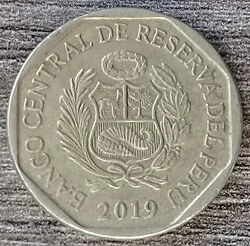
In Peru, the local currency is the Peruvian sol (PEN), symbolized as S/. Soles come in various denominations, with coins available in 10, 20, and 50 centavos (1 sol = 100 centavos) and 1, 2, and 5 sol coins. Paper bills come in 10, 20, 50, 100, and 200 sol denominations, with 10 and 20 sol bills being most commonly used in day-to-day transactions. As of November 2024, 1 sol = $0.26 (USD).
Accepted Payment Methods vary depending on location. In most major cities, including Lima, Cusco, and Arequipa, you’ll find that both Peruvian soles and US dollars (USD) are accepted at many hotels, tourist shops, and some restaurants. However, smaller towns and rural areas often deal exclusively in soles, so having local currency is essential. For larger purchases, such as car rentals or lodging, credit cards are widely accepted in urban areas, but Visa and MasterCard are the most commonly accepted brands. It’s also worth noting that smaller establishments may not accept credit cards or may charge additional fees, so confirm payment methods in advance where possible.
For highway tolls, local markets, small purchases, and tips, coins and smaller denominations of soles are preferred, as many vendors lack change for larger bills. If you’re traveling to remote areas, such as the Amazon or small Andean villages, ensure you carry enough cash in soles, as ATMs are rare and credit cards are typically not accepted. To ensure you’re prepared, consider carrying a mix of cash in both USD and soles along with a credit card for larger expenses.
Currency exchange options are widely available for tourists. Many international travelers exchange money at airport exchange kiosks upon arrival, although these often charge higher fees and offer lower rates. For better rates, you can exchange currency at authorized exchange houses (often marked as “Casa de Cambio”) or at major banks in cities. ATMs are also convenient for withdrawing local currency directly; however, be aware of withdrawal fees, which vary depending on the bank. ATMs that dispense soles and USD are common in cities, and withdrawing from a bank ATM often yields better rates than exchange kiosks. Many ATMs default to Spanish, but often have an option to switch to English. It’s best to avoid asking someone for help to protect your personal information, such as your PIN. In case you encounter an ATM without an English option, it’s helpful to know a few key Spanish terms:
ATM Spanish Terms to Know| English | Spanish |
| Card | Tarjeta |
| PIN | Contrasena |
| Withdraw | Retirar |
| Balance | Saldo |
| Checking Account | Cuenta corriente |
| Savings Account | Cuenta ahorros |
Average Costs for an Ecotourism Trip to Peru
The cost of an ecotourism trip to Peru can vary widely depending on the level of comfort and the types of activities chosen, but there are general price ranges for common goods and services. Domestic flights between cities like Lima and Cusco or Puerto Maldonado are typically around $50–$100 USD one-way, with occasional promotions available. For shorter city commutes, taxis are affordable, with fares within Lima’s center averaging $3–$6 USD, although longer trips, like from the airport to Miraflores, may cost closer to $15–$20 USD. Bus tickets offer a cost-effective option for long-distance travel; for example, a comfortable long-distance bus between Lima and Cusco may range from $20 to $70 USD depending on the service level. Groceries are generally inexpensive, especially for local produce, with basics like fruits, vegetables, and rice costing significantly less than in the U.S. However, imported goods can be pricier. For fuel, expect to pay around $5 USD per gallon, which is useful to keep in mind if renting a car. Lodging ranges widely, with budget hostels costing around $10–$25 USD per night, mid-range hotels around $50–$100 USD, and eco-lodges in remote areas varying from $50 up to $300 USD or more per night, depending on the location and amenities. Tour guides, essential for exploring protected areas or the Amazon, can cost $50–$100 USD per day or more for highly specialized tours. Dining out is affordable, especially at local eateries where meals average $3–$6 USD, while a mid-range restaurant meal may be closer to $10–$20 USD. Overall, Peru offers a range of budget-friendly to upscale options, allowing ecotourists to customize their experience based on their spending preferences.
Tipping Etiquette in Peru

In Peru, tipping is appreciated but not obligatory in many cases, with amounts and customs varying based on the service provided. In restaurants and bars, your bill will likely include a 10% tip for the wait staff. Hotel staff, such as bellhops and housekeeping, typically receive 2–5 soles per bag or day, and hotel concierges may be tipped around 10 soles for assistance. For tour guides and drivers, especially in ecotourism and adventure settings, it’s customary to tip 10–20 soles per person per day, with guides often receiving slightly more than drivers. Taxis generally do not require a tip, but rounding up the fare is a polite gesture. Similarly, tipping is not expected for street vendors, market sellers, or gas station attendants, although small amounts for exceptional service are appreciated. Following these general guidelines will show appreciation for good service without over-tipping where it isn’t customary.
Conclusion: The Importance of Ecotourism in Peru
Ecotourism plays a vital role in preserving Peru’s rich natural heritage, from the dense, wildlife-rich rainforests of the Amazon to the majestic peaks of the Andes. By choosing ecotourism, visitors contribute directly to the conservation of these unique ecosystems, support local communities, and help protect endangered species. Responsible ecotourism promotes sustainable practices that reduce human impact, allowing future generations to experience Peru’s unparalleled biodiversity and cultural richness. Every eco-conscious choice—whether hiring local guides, respecting protected areas, or choosing eco-lodges—supports the ongoing preservation of Peru’s fragile landscapes. As ecotourists, we have the privilege and responsibility to explore these remarkable places with care and respect, leaving a positive impact that ensures Peru’s extraordinary natural resources endure for generations to come. In this way, ecotourism not only enriches our lives as travelers but also strengthens Peru’s commitment to conservation and environmental stewardship.
Additional Resources for Ecotourism in Peru
Further Reading and Websites
U.S. Government
Recommended Apps for Peru Travel
- Waze (navigational app)
- MAPS.ME (downloadable maps available offline)
- Google Translate
- Duolingo (language learning app. Best used before travel, use Google translate during travel)

